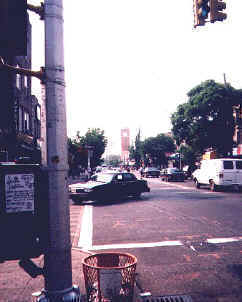 Medieval New York is meant to make readers
look around and see how the middle ages is interwoven with the physical, religious, and
physical fabric of New York City. I happened to live in north west Queens, or Astoria, an
area much more known for the situation comedy All in the Family than the middle
ages! When a New York Times reporter visited me recently, he noted wryly
"there's not much medieval around Astoria". On this page page I shall prove him
wrong!
Medieval New York is meant to make readers
look around and see how the middle ages is interwoven with the physical, religious, and
physical fabric of New York City. I happened to live in north west Queens, or Astoria, an
area much more known for the situation comedy All in the Family than the middle
ages! When a New York Times reporter visited me recently, he noted wryly
"there's not much medieval around Astoria". On this page page I shall prove him
wrong!
First we might as well admit that there is a lot of undistinguished tract architecture
in the neighborhood, but let's take a closer look...
[A map with all these spots highlighted is available.]
Astoria: Community and the Name
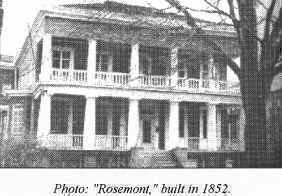 The people who lived in Queens in the period of the
European middle ages were Native Americans - Algonquians, Matinecocks, Jamecos, Rockaways.
The people who lived in Queens in the period of the
European middle ages were Native Americans - Algonquians, Matinecocks, Jamecos, Rockaways.
Queens County was settled as farmland in the 1640s after the Dutch founded Flushing in 1637 - the name is an anglicization of the Dutch port of Vlissingen.
The village of Astoria was developed in 1839 by one Stephen Halsey, aided by
the creation of a Ferry station at 92nd St in Manhattan. Bits and pieces of this
antebellum Astoria still exist, colonaded mansions and all - go to 12th Street between
26th Avenue and Astoria Park South to look them over.
In 1870 all of western Queens was chartered as Long Island City, an entity
that lasted until it was consumed by expanding New York City in 1898.
Until the eighteenth century the area now known as Astoria was known as Hallets
Cove after the Englishman William Hallett bought 1,500 acres along the shore
from the Dutch governor, Peter Stuyvesant in 1652. It was renamed in honor of the elder
John Jacob Astor, who had his summer home here. (The house was where Washington Irving
wrote his work on the fur tradel Astoria (online) [1836]). Some residents wanted to call the area Sunswick, an Indian name,
but Halsey persuaded them to change the the name in the hopes that Astor would donate
money to the village's young ladies' seminary; he eventually sent $500.
[ John Jacob Astor was born July 17,
1763 in Walldorf, Germany and died, March 29, 1848, New York City. His wealth began
in the fur trade, but he made real money in real estate. When he died he was richest man
in the U.S., and left $400,000 for the founding of a public library, the Astor Library,
later consolidated into the New York Public Library.]
None of this is especially medieval. But with some poetic license, there is a real
medieval slant to the name Astoria. After Visigothic Spain was conquered by the Muslims,
a small sliver of territory remained in the north. This area was known as the Asturias [see Map] and it was
from here that the gradual Christian "reconquest" of Spain took place. Even
today the son of the King of Spain - the heir to the throne - is known as the Prince
of the Asturias.
An Italian Campanile
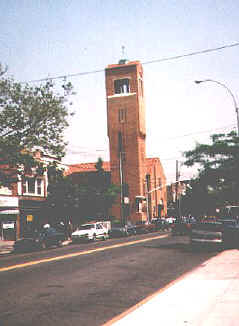
Campanile of Church of the
Immaculate Conception
|
Beginning in the northern part of Astoria, Ditmars Village, along Ditmars
Boulevard is perhaps the most Greek part of Astoria. But its sightlines are dominated by
the Roman Catholic Church of the Immaculate Conception.
The church itself is not especially notable, but it has dramatic campanile which is worthy of note. The campanile, or bell-tower, is a feature of any number
of medieval Italian ecclesiastical and muncipal structures. Like its Italian
prototypes, the Immaculate Conception campanile is built of brick, and has the
characteristic widening of the upper part of the tower.
Greek Orthodox Cathedrals
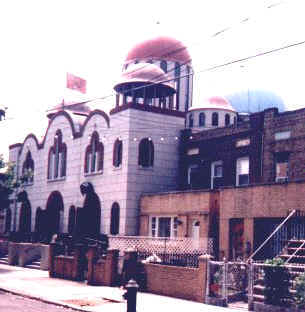
St. Markella's Cathedral
Astoria is far from exclusively a Greek enclave. Italians, Poles, Czechs,
Ukranians have also long been part of the mix. These days they have been joined by
Brazilians, Latin Americans from various hispanophone countries and a very significant
Indian and Pakistani population. But the Greek association is real: the area has more
Greeks than any urban area outside Athens; Greek food; Greek shop signs; and a variety of
Greek newspapers are available everywhere.
It is its Hellenism which gives the area a number of real links with
Byzantine (i.e. Medieval Greek) culture. This runs from visits by the Patriarch of Constantinople,
to the variety of processions for Greek saints, or around the Easter ceremonies, which
take over the streets.
Because of splits among the Greek Orthodox over the use of the Gregorian
versus the Julian calendar, there are a number of Orthodox Catherals in the area. Two of
these already have web pages on this site:
- St. Demetrius'
Cathedral (Greek Orthodox), 31st St., Astoria, Queens [Lauren Evans/Nicole
Polleta]
This in an almost perfect recreation of a small Byzantine Cathedral, like the churches of
Mistra or the older cathedral in Athens.
- St. Irene of
Chrysovalanton Monastery (Greek Orthodox/Old Calendar), 23rd Avenue, Astoria,
Queens [Lauren Evans/Nicole Polleta]
St. Irene's building is a conventional modern barn, but the interior is a dramatic and
forceful example of the sensual impact of a Byzantine church. Until May 1998, the
monastery was called a cathedral.
Although these two Orthodox groups were in schism, a reconciliation took place in May
1998 and St. Irene's became a "patriarchal and stavropegial monastery."
St. Markella of Chios,
(Hellenic Orthodox Traditionalist Church of America: Holy Diocese of Astoria), 22-68 26th
Street Astoria, N.Y. 11105 [offsite link] remains separate from the Greek Orthodox
Archdiocese. The link is to its own website. Since that site does not have a picture of
the church, I have provided one here. The church, which is still under construction,
claims that it is modeled on the 14th-century St. Saviour in
Chora in Constantinople.
A Modern Greek Orthodox Church
With a Dome Modeled on Hagia Sophia
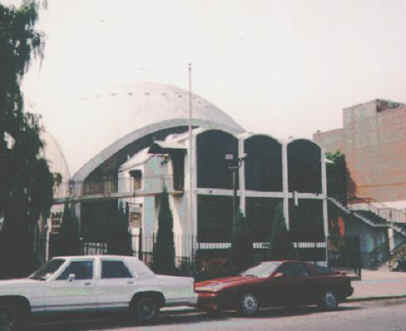
St. Catherine and St. George Church, 33rd St @ Ditmars.
The largest Orthodox church in the area is what appears at first sight to be the
completely modern church of St. Catherine and St. George. But look at that domed roof. Its
shape, not to mention the embedded windows, deliberately recall perhaps the most famous
Byzantine church - the Cathedral of Hagia Sophia in
Constantinople.
A Monophysite Congregation
In addition to the various Catholic and Orthodox religious buildings and paraphanalia,
immigrant Arab Christians from Egypt (called Copts from an adaptation of the
Greek word for "'Egyptians") have established a local congregation of the Coptic
Orthodox Church. This church, headed by the Patriarch of Alexandria, the only person
other than the Bishop of Rome called "pope" (currently its Pope Shenouda III),
descends from the theological conflicts of the fifth century when most Egyptian Christians
split from Greek and Latin speaking Christians over the exact words used to describe the
relationship of the human and divine in Christ.
This dispute, in which the Egyptian side, were called the "Monophysites" (a term that
they do not like, but which is hard to ditch after 1500 years), so weakened Byzantine
control in Egypt that the conquest of the country by Muslim forces around 640 CE was
comparatively easy.
A Romanesque Church
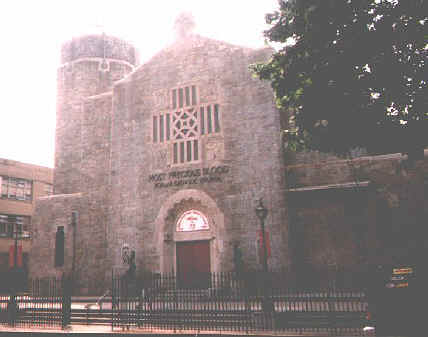
Most Precious Blood Church, 37th St. @ Broadway
At Most Precious Blood Church in Astoria, the special-language
Mass schedule for Sunday really brings out the variety of the area - It reads: 10:45
Croatian; 12:30 Italian; 5:00 Filipino; 6:30 Brazilian.
The church building itself, however, is a slightly modified Romanesque structure -
"Slightly modified" because there are a number of art deco elements in
the decoration. The simple styling, the squat impact, and the castle-like bell-tower all
make this a most pleasing church to visit..
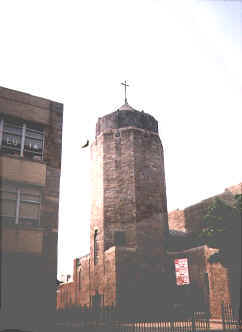
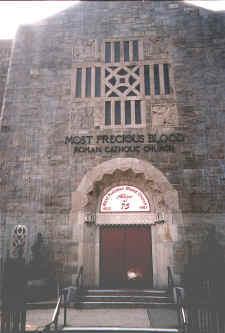
Moorish Detailing
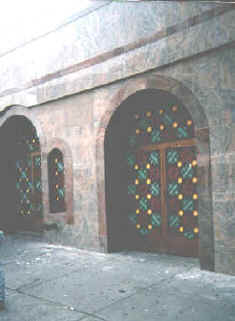 Astoria has seen large increase in its Mulsim population in
recent years. All over the place, small houses and storefronts are being used as mosques.
Astoria has seen large increase in its Mulsim population in
recent years. All over the place, small houses and storefronts are being used as mosques.
None of these building as yet is as striking as the major Manhattan Mosque on East 96th
St. And none can compete with the various churches. Recently, however, the storefront Mosque
on Steinway Street @ 25th Avenue carried out a major internal and external
renovation. Its marble exterior and the "moorish" detailing of the doors and
windows is meant to recall the glories of Islamic architecture. Unlike Christian art,
which has always focused on representational images of Christ, the Blessedd Vrigin Mary
and the saints, Muslim art has used pattern, shape and color to gain its effects.
Even in the busy shopping district of Steinway street - look closely, and
the Medieval heritage is there.
And Finally....
A Statue of the Man who Ended the Middle Ages
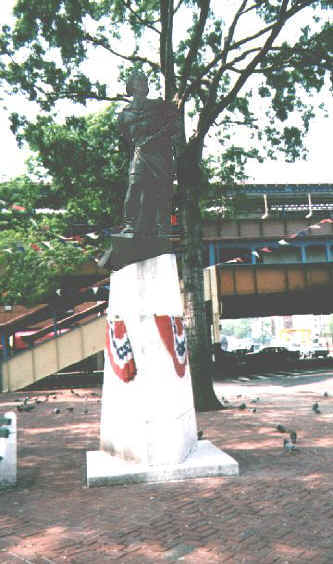
Christopher Columbus, Astoria Boulevard @ 31st Street.
Christopher Columbus' most
well known statue in New York is of course at Columbus Circle, but he also
has a statute just next to the Astoria Boulevard subway station.
By "discovering" America in 1492, Columbus began a process of globalization
of Western European culture which marks as useful point to end the middle ages, and this
tour.